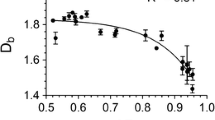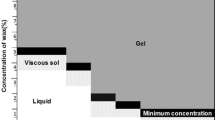Abstract
The microstructure, melting and crystallization behavior, rheological properties and oil binding capacity of crystalline networks of plant-derived waxes in edible oil were studied and then compared amongst different wax types. The critical concentrations for oleogelation of canola oil by rice bran wax (RBX), sunflower wax, candelilla wax, and carnauba wax were 1, 1, 2, and 4 %, respectively, suggesting RBX and sunflower wax are more efficient structurants. A phenomenological two-phase exponential decay model was implemented to quantify the oil-binding capacity of these oleogels. Parameters obtained from this empirical model were then evaluated against microscale structural attributes such as crystal size, mass distribution and porosity to determine the structural dependence of oil-binding capacity. Gels containing candelilla wax exhibited the greatest oil-binding capacity, as they retained nearly 90 % of their oil. This is due to the small crystal size as well as the spatial distribution of these crystals. Using a microscopic to macroscopic approach, this study examines how the structural characteristics unique to each wax and resulting oleogel system affect functionality and macroscopic behavior.












Similar content being viewed by others
References
Health Canada (2014) General questions and answers on trans fats. http://www.hc-sc.gc.ca/fn-an/nutrition/gras-trans-fats/tfa-age_question-eng.php. Accessed 02 Feb 2014
American Heart Association (2014) Trans fats (online). http://www.heart.org/HEARTORG/GettingHealthy/FatsAndOils/Fats101/Trans-Fats_UCM_301120_Article.jsp. Accessed 02 Feb 2014
Norris S (2007) Trans fats: the health burden. Parliamentary Research and Information Service, Science and Technology Division PRB 05-21E
Health Canada (2014) Trans fat monitoring program (Online). http://www.hc-sc.gc.ca/fn-an/nutrition/gras-trans-fats/tfa-age_tc-tm-eng.php. Accessed 02 Feb 2014
Marangoni AG (2002) The nature of fractality in fat crystal networks. Trends Food Sci Technol 13:37–47
Sato K (2005) Polymorphism in fats and oils. In: Shahidi F (ed) Bailey’s industrial oil and fat products, vol 1, 6th edn. Wiley, Hoboken, pp 77–120
Le Révérend B, Fryer PJ, Coles S, Bakalis S (2010) A method to qualify and quantify the crystalline state of cocoa butter in industrial chocolate. J Am Oil Chem Soc 87:239–246
Marangoni AG, McGauley S (2002) Static crystallization behaviour of cocoa butter and its relationship to network microstructure. In: Marangoni AG, Narine SS (eds) Physical properties of lipids. CRC Press, Boca Raton, pp 85–124
Flory PJ (1953) Principles of polymer chemistry. Cornell University Press, Ithaca
Marangoni AG, Garti N (2010) Novel strategies for nanostructuring liquid oils into functional fats. In: Marangoni AG, Garti N (eds) Edible oleogels: structure and health implications. AOCS Press, Urbana-Champaign, pp 5–10
Dassanayake LSK, Kodali DR, Ueno S, Sato K (2009) Physical properties of rice bran wax in bulk and organogels. J Am Oil Chem Soc 86:1163–1173
Toro-Vazquez JF, Morales-Rueda JA, Dibildox-Alvarado E, Charó-Alonso M, Alonzo-Macias M, González-Chávez MM (2007) Thermal and textural properties of organogels developed by candelilla wax in safflower oil. J Am Oil Chem Soc 84:989–1000
Hwang HS, Kim S, Singh M, Winkler-Moser JK, Liu SX (2012) Organogel formation of soybean oil with waxes. J Am Oil Chem Soc 89:639–647
Rocha JCB, Lopes JD, Mascarenhas MCN, Arellano DB, Guerreiro LMR, da Cunha RL (2013) Thermal and rheological properties of organogels formed by sugarcane or candelilla wax in soybean oil. Food Res Int 50:318–323
Food and Agricultural Organization (2013) FAO rice market monitor. XVI(2) (Online). http://www.fao.org/economic/est/publications/rice-publications/rice-market-monitor-rmm/en/. Accessed 02 July 2013
Food and Agricultural Organization (2013) Minor oil crops—individual monographs (Noog abyssinia–Nutmeg; Perilla–Pili nut; Rice bran–Sacha inche) (Online). http://www.fao.org/docrep/x5043e/x5043e0a.htm. Accessed 02 July 2013
Food and Agricultural Organization (2013) Agribusiness handbook—sunflower crude and refined oils (Online). http://www.responsibleagroinvestment.org/sites/responsibleagroinvestment.org/files/FAO_Agbiz%20handbook_oilseeds_0.pdf. Accessed 02 July 2013
Martini S, An MC (2000) Determination of wax concentration in sunflower seed oil. J Am Chem Soc 77:1087–1092
Secretaría de Medio Ambiente y Recursos Naturales (2013) Anuarios de la Producción Forestal. http://www.cnf.gob.mx:8080/snif/portal/component/phocadownload/category/23-anuarios-estadisticos?download=151:anuarios-estadisticos-de-la-produccion-forestal-2009. Accessed 02 July 2013
Dassanayake LSK, Kodali DR, Ueno S, Sato K (2012) Crystallization kinetics of organogels prepared by rice bran wax and vegetable oil. J Oleo Sci 61:1–9
Co E, Marangoni AG (2012) An alternative edible oil-structuring method. J Am Oil Chem Soc 89:749–780
Botega DC (2012) Application of rice bran wax organogel to substitute solid fat and enhance unsaturated fat content in ice cream. M.Sc. thesis, Department of Food Science, University of Guelph, Guelph, Canada
Toro-Vazquez JF, Alonzo-Macias M, Dibildox-Alvarado E, Charó-Alonso MA (2009) The effect of tripalmitin crystallization on the thermomechanical properties of candelilla wax organogels. Food Biophys 9:199–212
Smith KW, Bhaggan K, Talbot G, van Malssen KF (2011) Crystallization of fats—influence of minor components and additives. J Am Oil Chem Soc 88:1085–1101
Wright A, Marangoni AG (2002) Effect of DAG on milk fat TAG crystallization. J Am Oil Chem Soc 79:395–402
Kerr RM, Tombokan X, Ghosh S, Martini S (2011) Crystallization behaviour of anhydrous milk fat—sunflower oil wax blends. J Agric Food Chem 59:2689–2695
Narine SS, Marangoni AG (1999) Relating structure of fat crystal networks to mechanical properties: a review. Food Res Int 32:227–248
Marangoni AG, Tang D (2006) Microstructure and fractal analysis of fat crystal networks. J Am Oil Chem Soc 83:377–388
Narine SS, Marangoni AG (1999) Fractal nature of fat crystal networks. Phys Rev E 59:1908–1920
Acknowledgments
The authors acknowledge the financial support of the Natural Sciences and Engineering Research Council of Canada.
Author information
Authors and Affiliations
Corresponding author
About this article
Cite this article
Blake, A.I., Co, E.D. & Marangoni, A.G. Structure and Physical Properties of Plant Wax Crystal Networks and Their Relationship to Oil Binding Capacity. J Am Oil Chem Soc 91, 885–903 (2014). https://doi.org/10.1007/s11746-014-2435-0
Received:
Revised:
Accepted:
Published:
Issue Date:
DOI: https://doi.org/10.1007/s11746-014-2435-0




